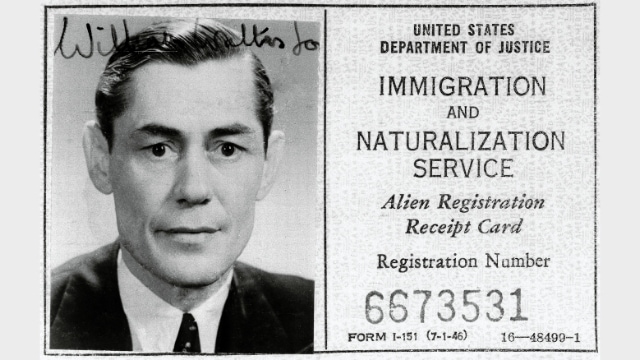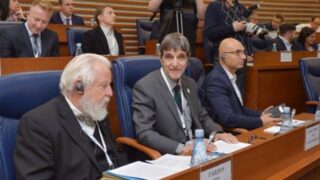Brainwashing theories: origins, application in the military field, and to religious groups, up to their discredit. Are mind control theories making a comeback?
by Massimo Introvigne*
*This article collects, for ease of reading, a series of articles published on this site in August 2021.


Table of Contents
“Brainwashing”: A False Accusation Against Unpopular Minorities
We are at it again. New books are launched with great fanfare that revive old theories of “brainwashing,” and almost everybody, from Donald Trump to Bill Gates, is accused of using “mind control techniques” to gather followers. And of course, that they use “brainwashing” is an old accusation against groups discriminated and labeled as “cults.”
Do these techniques exist? That the answer is “no” is one of the key conclusions of the academic discipline of the study of new religious movements (NRM studies). A tiny minority of scholars of religious movements, with connections to the anti-cult activists, rejected this conclusion, seceded from the majority, and created a different discipline of “cultic studies.” However, as Mike Ashcraft emphasized in his authoritative textbook on the academic study of new religious movements, while NRM studies are generally regarded as a legitimate part of the scholarly study of religions, “cultic studies” are “not mainstream scholarship.”
Origins of the brainwashing theories
But where do “brainwashing” theories come from? At first, I discuss the remote origins of “brainwashing” theories. In subsequent chapters, I will explain how the idea that “brainwashing” was practiced by Communists in Russia and China got discredited, how it was applied to religions and “cults,” was rejected by mainline scholars and courts of law, but now tries to come back.
Humans tend to believe that some ideas and religions are so “strange” that nobody can embrace them freely. Romans believed that Christianity was such an absurd religion that those who had converted to it had been bewitched through black magic techniques. Chinese believed the same since the Middle Ages with respect to religions not approved by the Emperor (including, initially, Buddhism). These religions could only gain converts through black magic. In Europe, when Christians became a state-supported majority, they adopted the same explanation for conversion to “heretical” faiths such as the one preached by the Waldensians, which were in turn accused of “bewitching” their converts.
After the Enlightenment, belief in black magic declined but the idea that strange religions could not be joined voluntarily but only through bewitchment was secularized as hypnosis. Mormons, in particular, were accused of hypnotizing their “victims” into conversion.
In the 20th century, ideas that some believed were so “strange” and dangerous that nobody could embrace them freely emerged in a field different from religion, politics. German Socialist scholars, at loss for an explanation of how not only the bourgeois but also workers and the poor could convert en masse to Nazism spoke of “mass hypnosis” or “mental manipulation.” Later, with the Cold War, the same explanation was used in the United States why some can embrace such an absurd ideology as Communism.
Brainwashing, CIA and the fight against Communism
In the case of Communism, the American Central Intelligence Agency (CIA), founded in 1947, believed they had found a smoking gun in techniques used in Chinese and North Korean Communist jails and concentration camps against arrested Western missionaries and, later, American prisoners of war captured during the Korean War. American psychiatrists and psychologists such as Robert Jay Lifton and Edgar Schein were asked to interview those who had been liberated from Communist jails and camps. Their conclusions were very cautious, as they noticed that in fact Chinese techniques had not converted many, and the majority of those who had signed declarations of allegiance to Communism had done so to escape torture or mistreatment in jail, and had not really been persuaded. They were also criticized for their psychoanalytic approach and, in the case of Lifton, for a libertarian idea of human agency that later led him to support the anti-cult movement. However, they maintained that Chinese mental manipulation techniques either worked in a very limited number of cases, when they were accompanied by the use of mind-altering drugs and torture, or did not work at all.
The CIA, however, decided to present the thesis that people did not convert freely to Communism in much simpler, black-and-white terms, claiming in its propaganda that both the Chinese and Soviet Communists had developed an infallible technique to change the ideas of their victim “like a [vinyl] disc was changed on a phonograph,” as CIA director Allen Welsh Dulles explained in 1953.
The CIA instructed one of its agents whose cover job was that of a journalist, Edward Hunter, to “invent” and spread the word “brainwashing,” presenting it as the translation of an expression allegedly used by the Chinese. In fact, the CIA and Hunter had taken the concept of “brainwashing” from the novel 1984 by George Orwell, where Big Brother “washes clean” the brains of the citizens of a fictional regime modeled after Soviet Russia.
The idea that Communists in China and Russia, and Communist spies in the West, had mastered the techniques of “brainwashing” became immensely popular. We can see its triumph in popular culture in the 1959 novel The Manchurian Candidate and its 1963 movie version starring Frank Sinatra and Angela Lansbury. Soon, however, the CIA itself had to admit that brainwashing did not work. We will see these developments in the next chapter.


Testing “Brainwashing” Theories: CIA and the MK-Ultra Experiment
In the previous chapter we saw how CIA propaganda created the word and a theory of “brainwashing” to explain why intelligent people might embrace such an absurd doctrine as Communism was, and to accuse the Soviet and Chinese Communists of sinister practices depriving their victims of their free will.
Paradoxically, the CIA came to believe in its own propaganda, and tried to replicate the Communist “brainwashing” in its own experiments.
TheMK-ULTRA project
The CIA secret “brainwashing” project was codenamed the MK-ULTRA project. Originally, it was only mentioned in a handful of publications critical of the US government, and often dismissed as supporting conspiracy theories. Later, however, the CIA became the defendant in several lawsuits filed by “volunteers” who had suffered permanent damages in the MK-ULTRA experiments and their relatives, the most important of which resulted in a 1988 settlement. Through the lawsuits, several key documents became public.
It was thus confirmed that, to further its “brainwashing experiments,” the CIA had secured the cooperation of several leading American universities and scholars, who were on the cusp of advanced research on behavioral sciences. Not all of them were fully aware of the ultimate aims of the project, and the CIA hid under three foundations that were allegedly private.
The first results were not encouraging. Each research team adopted one or more specific methods such as hallucinogenic drugs, psychotropic medications administered in higher-than-normal doses, sensorial deprivation, repeated electroshock treatments, lobotomy and other forms of psychosurgery, and hypnosis. Some of the “volunteers” were prison inmates, others were psychiatric patients of the researchers, or homeless citizens who had been promised significant amounts of cash.
The CIA project took a quality leap when Donald Ewen Cameron, a distinguished Scottish psychiatrist who was Professor of Psychiatry at McGill University in Montreal, joined the effort. Cameron will later become president of the American Psychiatric Association, and found the World Psychiatric Association. In a protracted series of experiments on his Canadian patients, he combined many of the techniques that had formerly been tested separately. The CIA also appreciated that Cameron was working in Canada, thus circumventing legal restrictions forbidding such experiments in the United States.
Depatterning and psychic driving
Cameron based his experiments on a two-stage theory. In the first stage, which he called “depatterning,” he set out to eliminate the subject’s existing ideas, habits, and attachments, generating a sort of “selective amnesia.” The outcome of this stage, in the words of a CIA executive, was the “creation of a vegetable,” not an especially useful subject for counter-espionage purposes. But then Cameron moved to the second stage that he called “psychic driving,” in which the subject was “reconditioned” to adopt new, permanent behavioral models and ideas.
In fact, Cameron was even too successful in creating “vegetables.” Some of the techniques he used included electroshock treatments that were from twenty to forty times stronger than the average doses administered in psychiatric hospitals, and he gave them to the patients three times a day for several days. He also administered medication to induce sleep deprivation for periods from fifteen to sixty-five days. He gave his patients cocktails of psychotropic drugs and hallucinogens, in quantities much higher than in their normal recreational use. Not surprisingly, as court cases were to reveal in later years, most of the patients succumbed to mental and other illnesses, and never recovered. Some died.
The passage from depatterning to psychic driving, however, never succeeded. Cameron recorded on tape his own “instructions,” as well as phrases spoken by the patient. The vegetable-like patients produced by the depatterning were compelled to listen to the tapes up to sixteen hours a day. Sometimes, microphones were inserted in football helmets that patients could not remove. Microphones were also hidden under their pillow, so they could continue to listen to the tapes even in their sleep. But nothing worked.
In fact, Cameron’s experiments did prove something. They proved that “brainwashing” a victim into changing her fundamental ideas or orientation was not possible. Having reached the same conclusions, in 1963 the CIA ended the MK-ULTRA project, including the part that Cameron had conducted.
To use its own fortunate metaphor, the CIA learned that it might be possible to “wash” the brain until it loses its “color” and becomes “white,” as the patient is reduced to the sad state of a human wreck. But “recoloring” it with new ideas is not possible.


How “Brainwashing” Theories Were Applied to Religion
In previous chapters of this article, we saw how the CIA coined the word “brainwashing,” and accused Communists of using sinister mind control techniques. At some stage, the CIA started believing its own propaganda and launched a secret experiment codenamed MK-Ultra, where it tried to “brainwash” so-called volunteers. The project failed, and proved that “brainwashing” techniques may reduce the unfortunate victims to vegetable-like human wrecks, but cannot install in them new ideas or loyalties.
L. Ron Hubbard and brainwashing
One who, without probably being aware that the secret MK-Ultra Project was being planned, had anticipated that the only possible result of violent “brainwashing” would be the production of zombie-like victims was the founder of Scientology, L. Ron Hubbard. He had a peripheral involvement in the Cold War discussion about “brainwashing” as the Church of Scientology published in 1955 (and then rapidly withdrew, reportedly following a suggestion by American governmental agencies) a booklet called Brain-Washing: A Synthesis of the Russian Textbook on Psychopolitics. Ostensibly, it was a Communist manual for “brainwashing,” and whether Hubbard compiled it himself or edited materials received from others (possibly one of the American intelligence agencies) is a matter of debate I have discussed at length elsewhere.
Critics have alleged that, by publishing the booklet, Hubbard “confessed” that “brainwashing” existed, with the implication that Scientology practices it, which they claim is supported by a statement that “We can brainwash faster than the Russians (20 secs to total amnesia against three years to slightly confused loyalty).” However, critics have overlooked that Hubbard presented “brainwashing” as something that should not be done and does not work. The “brainwashing” he had in mind was the one attributed to the Communists, where results were sought by inflicting pain and stuffing the victim with heavy drugs. Hubbard called this technique “pain-drug hypnosis.” It was something different from the “brainwashing” new religious movements will be accused of practicing decades later, where no pain nor drugs were normally involved.
Not only was this kind of “brainwashing” unethical, Hubbard said, it would never work. “I repeat that, Hubbard stated in one of his 1956 Games Congress lectures. It is not effective. It does not do a job. […] It is a hoax—a hoax of the first order of magnitude. The Communist cannot brainwash anybody who is not [already] brainwashed. He cannot do it; he does not know how. It is one of these propaganda weapons. That’s all it is. They [Communists] say, ‘have this terrific weapon called brainwashing—we’re going to brainwash everybody.’ Well, it would be awfully dangerous if they could. But do you know there is practically not a person in this room that would be permanently harmed by brainwashing, except as it related to being starved and kept under conditions of duress. In other words, if you put a guy into a military stockade and fed him poorly for two or three years, he is going to be in secondhand condition, isn’t he? Well, that’s just exactly the effect brainwashing had on them. It had no more effect than this.”
As mentioned above, Hubbard was right on this point, and the infamous MK-Ultra experiments had the only valuable results of confirming that “brainwashing” cannot change ideologies or beliefs.
The Battle for the Mind: A Physiology of Conversion and Brainwashing
But how did the accusation of practicing “brainwashing” traveled from Communists to the “cults”? The first author who applied the CIA’s rhetoric of “brainwashing” to religion was English psychiatrist William Walters Sargant in his 1957 book The Battle for the Mind: A Physiology of Conversion and Brainwashing, which became an international bestseller. Sargant popularized the idea that “brainwashing” techniques had been derived in Russia from the famous experiments of Stalinist scientist Ivan Pavlov, where a dog accustomed to hearing a bell ringing every time it was given food, ended up salivating when the bell rang but no food was served. Some psychiatrists still believe in this theory, although Soviet and Chinese sources failed to confirm that Pavlov played any main role in their studies of indoctrination techniques.
The central argument in Sargant’s work was that Communists did not invent “brainwashing.” At most, he believed, thanks to Pavlov, they reached a better understanding of the process, which they adapted from pre-existing religious revivalism and conversion processes. Sargant wrote: “Anyone who wishes to investigate the technique of brainwashing and eliciting confessions as practiced behind the Iron Curtain … would do well to start with a study of eighteenth-century American revivalism from the 1730’s onwards.”
Although in the third edition of his book, published in 1971, Sargant will include Scientology among the religions practicing “brainwashing,” he did not believe that there was a difference between mainline religions, which did not use mental manipulation, and “cults,” which did. On the contrary, Sargant was decidedly anti-Christian, and he mentioned the Roman Catholics and the Methodists as two groups typically using “brainwashing,” and accused of the same sin the first Christians. The English psychiatrist believed that only “brainwashing” could explain the rapid growth of early Christianity.
Even Apostle Paul’s conversion as recorded in the Bible, Sargant argued, might be explained through a “brainwashing” scheme, with the Christian Ananias “brainwashing” the Jewish, and originally anti-Christian, Paul. “A state of transmarginal inhibition seems to have followed his [Paul’s] acute stage of nervous excitement [… and] increased his anxiety and suggestibility […]. Ananias came to relieve his nervous symptoms and his mental distress, at the same time implanting new beliefs.”
The birth of anti-cult ideology
Many read Sargant’s book, particularly within the psychiatric community, where it certainly fueled a hostile attitude to religion in general. However, its target was too broad to make the book of any use for promoting public policies. It was in the United States that psychologist Margaret Thaler Singer re-elaborated the ideas of Sargant claiming that not all religions used “brainwashing,” only some newly founded that were not exactly religions but “cults.” This happened in the climate of the 1960s and early 1970s, when the anti-cult movement was just being created, mostly among parents of college students who had decided to drop out of their universities to become full-time missionaries for the Unification Church or the Children of God, or shaved Hindu monks for the Hare Krishna Movement. As it happened for “heresies” of the past, their parents did not believe that their choices had been voluntary, and psychologists such as Singer offered “brainwashing” to them as a convenient explanation.
Singer was instrumental in creating the anti-cult ideology, which is based on the idea that “cults,” which use “brainwashing,” may be distinguished from legitimate religions, which don’t. Eventually, however, this theory was discredited by scholars and rejected by courts of law, as we will see below.


The Fall of “Brainwashing” Theories in the Late Twentieth Century
The anti-cult movement and “deprogramming” practices
One of the most tragic consequences of “brainwashing” theories applied to religious minorities is that they were used to justify the illegal practice of “deprogramming,” created by Ted Patrick in California and flourishing in the 1970s. If their sons and daughters had been “brainwashed,” these parents felt justified in hiring “deprogrammers” who claimed to be able to kidnap the “cultists,” detain them, and persuade them, more or less violently, to abandon the “cults.”
In the same years, the academic study of the new religious movements was born, both in the United States and the United Kingdom. The scholars who studied the movements criticized as “cults” found that conversions to them happened much in the same way as conversions to any other religion, and only a small percentage of those attending the courses and seminars of groups like Unification Church, studied in depth by Eileen Barker and where allegedly miraculous techniques of “brainwashing” were used, joined the groups. Empirical evidence confirmed that there was no “brainwashing” or mental manipulation, and these labels and theories were not less pseudo-scientific than the ancient claims that “heresies” converted their followers through black magic.
The scholars were successful in marginalizing the use of the word “cult” and the “brainwashing” theories in the academic community, but the controversy moved to courts of law. Deprogramming had become a very lucrative profession, and a cover for other illegal activities, some law firm believed former members can sue new religious movement claiming damages for “brainwashing,” and substantial financial interests had entered the field.
From the Fishman case and to the ban of deprogramming
It took a good decade for the majority scholarly opinion, that “brainwashing” and mind control were pseudo-scientific theories, to prevail in courts of law. The decisive confrontation happened in the US District Court for the Northern District of California in 1990, in the Fishman case. Steven Fishman was a “professional troublemaker,” who attended the stockholders’ meetings of large corporations for the purpose of suing the management with the support of other minority stockholders. He then signed settlements and pocketed the money paid by the corporations, leaving the other stockholders who had trusted him empty-handed. In a lawsuit brought against him for fraud, Fishman claimed in his defense that at the time he was temporarily incapable of understanding or forming sound judgments, because he was a member of the Church of Scientology since 1979, and as such had been subjected to “brainwashing.” Scientology was not a part of the suit, and had nothing to do with Fishman’s wrongdoings (although years later Fishman would falsely claim otherwise).
Having examined in detail the documents of the scholarly discussion about “brainwashing,” Judge D. Lowell Jensen concluded that “brainwashing” and mind control “did not represent meaningful scientific concepts,” and while defended by a tiny minority of academics, had been rejected as pseudo-scientific by an overwhelming majority of the scholars studying new religious movements. Singer’s testimony was declared not admissible, and Fishman went to jail.
Fishman was the beginning of the end for the use of “brainwashing” anti-cult theories in American courts. For anti-cultists, worse was to come in 1995, when deprogrammer Rick Ross was involved in a civil trial after he had unsuccessfully tried to deprogram Jason Scott, a member of the United Pentecostal Church, a 5-million strong Christian denomination few would regard as a “cult” or a new religious movement. Scott was supported by Scientology lawyers and detectives, which proved that his mother was referred to Ross by the Cult Awareness Network (CAN), at that time the largest American anti-cult movement. CAN was sentenced to pay millions in damages, and went bankrupt. CAN’s name and assets were purchased by a Scientology-related group, which allowed sociologist Anson D. Shupe and his team free access to CAN archives. They concluded that the former CAN’s practice of referring the parents of “cult” members to deprogrammers was not an occasional occurrence but happened regularly. In turn, the “deprogrammers” kicked back to the “old” CAN hefty (and probably illegal) commissions.
After the Scott case, deprogramming became illegal in the United States, and deprogrammers who continued their activities had to claim that they were now operating on a voluntary basis through “interventions” or “exit counseling.” Most democratic countries, and the European Court of Human Rights, also outlawed deprogramming. In Japan, deprogramming was not stopped by courts of law until the seminal decision of the Tokyo High Court in the case of Unification Church member Goto Toru in 2014, confirmed by the Supreme Court in 2015. Human Rights Without Frontiers campaigned for years on behalf of Goto, and played a crucial role in securing this decision.
Only in South Korea, deprogramming continues to this date, particularly against a Christian new religious movement, Shincheonji, notwithstanding massive street demonstrations in 2018 after a female member of that group, Gu Ji-In, was strangled to death by her father while she tried to escape the deprogrammers.
But in general, deprogramming has been truly discredited, and the Fishman and Scott decisions have created a serious barrier against the use of “deprogramming” theories in U.S. court cases. Yet, anti-cultists have not given up, as we will see in the next chapter.


Are “Brainwashing” Theories Coming Back?
In the previous chapter, we saw how the combined action of scholars of new religious movements and courts of law marginalized both theories of “brainwashing” and their use as a legal weapon against “cults.”
The idea that “cults” practice mental manipulation or “brainwashing” survived in the popular media, and inspired laws and court decisions outside the United States, particularly in France. However, the arguments formulated by a large majority of the leading scholars of new religious movements, and mentioned in the Fishman decision, do not refer to the United States only. “Brainwashing” and mental manipulation remain concepts rejected as pseudo-scientific by a vast majority of the scholars of religion (although accepted by a minority, and by some psychiatrists and psychologists who do not specialize in religion).
In the second half of the 1990s, James T. Richardson, who had played an important role in criticizing anti-cult “brainwashing” theories, systematically surveyed with some colleagues all American court cases where the word “brainwashing” appeared. They continued the survey in the new century. They found that after Fishman, the use of “brainwashing” arguments in litigation against new religious movements had almost disappeared, but the word survived in other fields of the law.
“Brainwashing” by a variety of sources (including teachers, pastors, therapists, and even the US government) was used, although rarely with success, as a defense in criminal cases, just as it had happened in the earlier Patty Hearst trial. Much more successful was the idea, used in custody litigation, that one divorced parent had “brainwashed” children into hating their other parent.
Theparental alienation syndrome
This was called “parental alienation syndrome” (PAS), a theory created by American child psychiatrist Richard A. Gardner, who explicitly based it on “brainwashing.” Answering his critics in an article published posthumously (he died in 2003), Gardner wrote that, “It is true that I do focus on the brainwashing parent, but I do not agree that such focus is ‘overly simplistic.’ The fact is that when there is PAS, the primary etiological factor is the brainwashing parent. And when there is no brainwashing parent, there is no PAS.”
Gardner’s theory was widely criticized. In 1996, a Presidential Task Force of the American Psychological Association concluded that “there are no data to support the phenomenon called parental alienation syndrome.” However, PAS continues to be used as an argument in divorce and custody cases, not only in the United States, and the heated discussion about Gardner’s theories kept alive an international controversy on “brainwashing.”
California and Hawaii, England and Wales, and Tasmania and Queensland in Australia, followed by others, passed laws against “coercive control,” defined as intimidation, surveillance, and isolation within a context of domestic abuse or stalking. Although the laws refer to a specific abusive behavior, the shadow of “brainwashing” hangs over the statutes, making them difficult to enforce. Sometimes, critics argue, it is the perpetrators who accuse the victims of manipulation through “coercive control.”
Brainwashing and 9/11
“Brainwashing” was also proposed after 9/11 as a folk explanation of how terrorists, some from wealthy families, had joined al-Qa’ida and later the Islamic State. Anti-cultists offered themselves as experts on Islamic radicalism, claiming that al-Qa’ida and other radical Muslim organizations were basically “cults,” which was also true for other non-Muslim terrorist groups. However, their lack of information on the Islamic context and on the specialized academic field of terrorism studies quickly became apparent, and they were largely ignored by the academic community and government agencies dealing with counterterrorism.
“Trumpism” and QAnon
“Brainwashing” theories, however, came back as explanations of the Trump phenomenon and of how it was possible that millions of American citizens (and not a few non-Americans) supported QAnon and other movements and networks promoting wild conspiracy theories. Old hands of the anti-cult movement, such as former deprogrammer Steve Hassan, just applied Singer’s “brainwashing” theory to “Trumpism” and QAnon. The title of Hassan’s 2019 book, The Cult of Trump: A Leading Cult Expert Explains How the President Uses Mind Control already told it all.
The wild claims of QAnon and the assault on Capitol Hill of January 6, 2021, lent credibility to the theory that the extreme pro-Trump fringe included victims of “brainwashing,” and even Hassan was taken seriously by some media.
Paradoxically, QAnon and similar movements were themselves persuaded that “brainwashing” was being used on the American political scene—by the Democrat Party, the “deep state,” and what an author who wrote an opus in no less than 43 volumes about the issue called the “Marxist-Zionist-Jesuit-Masonic-Black Nobility-Illuminati-Luciferian death cult.”
There was, however, a difference on how the anti-Trump and the pro-Trump camps referred to “brainwashing.” Critics of Trump and those who denounced QAnon as a “cult” basically revived the anti-cult model of “brainwashing,” based on mind control achieved through psychological manipulation. On QAnon, on the other hand, one would find more often, together with references to the MK-ULTRA project, which had allegedly been secretly continued by rogue “deep state” operatives after its official demise in 1963, the idea that “brainwashing” was achieved through magic. Sometimes, it was the modern magic of mysterious mind-controlling rays directed on unsuspecting American homes from satellites, chips implanted by unscrupulous medical doctors, or drugs hidden in anti-COVID-19 vaccines by conspirators led by Bill Gates or George Soros. In other cases, QAnon postings mentioned that deep state “brainwashing” worked by mobilizing black magic in a very traditional sense, through spells, rituals of witchcraft, human sacrifice of children, or invocations to Satan and his minions. Trump’s camp always included believers in magic, as Egil Asprem demonstrated, and denouncing Hillary Clinton and other Democrat leaders as involved in Satanism was a key part of the QAnon narrative.
In a sense, the “brainwashing” discourse had come full circle. The idea that those who embraced deviant beliefs had been bewitched by black magic had been secularized twice, first as hypnosis and then as “brainwashing.” Now, black magic with its traditional paraphernalia of sinister enchantments and Devil worship came back to be adopted by some QAnon followers as the only possible explanation why otherwise sane, patriotic, and even Republican Americans had been persuaded first that Trump was up to no good, and then that he had lost the 2020 elections, rather than being cheated out of his victory by the deep state’s ability to simultaneously “brainwash” millions of citizens. In turn, confronted with the strange fact that millions in the 21st century came to believe in such bizarre theories, others concluded that Trump and QAnon radical followers had been in turn “brainwashed.”
More than seventy years after CIA agent Hunter coined the word “brainwashing,” we are still experiencing the contradiction between a majority of academic scholars of religion, who have largely rejected “brainwashing” as pseudoscience, and a popular culture and segments of the mental health professions where the “brainwashing” explanation of why many join “deviant” groups and ideologies remains so powerful that it refuses to go away. It comes back every time new and seemingly unexplainable forms of deviance create a market for easy explanations.









